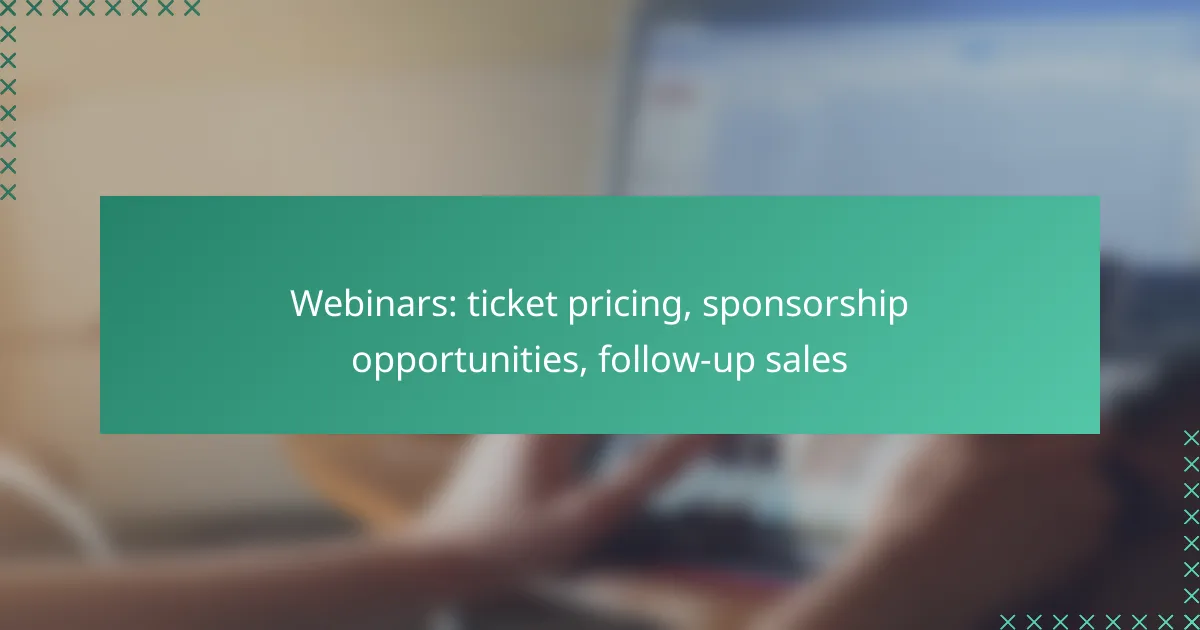Webinars present a unique opportunity to engage audiences, but pricing tickets effectively is essential for maximizing attendance and revenue. Additionally, securing sponsorships can enhance the event while providing valuable exposure for brands. After the webinar, implementing strategic follow-up sales tactics can help convert attendees into loyal customers.

How to price webinar tickets in Canada?
Pricing webinar tickets in Canada requires careful consideration of market trends, audience willingness to pay, and the value offered. A well-structured pricing strategy can significantly impact attendance and revenue.
Market average pricing
The market average for webinar ticket pricing in Canada typically ranges from CAD 20 to CAD 100, depending on the topic and audience. Researching similar webinars can help you identify a competitive price point that attracts participants while ensuring profitability.
Consider factors such as the duration of the webinar, the expertise of the speakers, and the perceived value of the content when determining your pricing strategy.
Tiered pricing strategies
Implementing tiered pricing can cater to different audience segments and maximize revenue. For instance, you might offer a basic ticket for CAD 30, a standard ticket for CAD 50, and a premium ticket for CAD 80, each with varying levels of access or additional resources.
This approach encourages attendees to opt for higher-priced tickets by highlighting the added value, such as exclusive content or one-on-one consultations.
Early bird discounts
Early bird discounts incentivize attendees to register ahead of time, typically offering a reduced price for those who sign up weeks before the event. For example, you could offer a CAD 10 discount for registrations made at least two weeks in advance.
This strategy not only boosts initial sales but also helps with planning and logistics by providing an early estimate of attendance.
Value-based pricing
Value-based pricing focuses on the perceived value of the webinar to the audience rather than just costs. Assess what unique insights or benefits your webinar provides and set your price accordingly.
For instance, if your webinar features industry leaders or exclusive research, you might justify a higher ticket price, as attendees are likely to see greater value in the content offered.
Competitor analysis
Conducting a competitor analysis is essential for understanding the pricing landscape. Identify similar webinars in your niche and analyze their pricing structures, attendance rates, and promotional strategies.
This information can guide your pricing decisions and help you position your webinar effectively in the market, ensuring you remain competitive while appealing to your target audience.

What are the sponsorship opportunities for webinars?
Sponsorship opportunities for webinars allow businesses to promote their brand while supporting the event. These can include financial contributions, product placements, or promotional partnerships that enhance the webinar experience for attendees.
Types of sponsorships
There are several types of sponsorships available for webinars. Common options include title sponsorship, where a brand is prominently featured as the main sponsor, and session sponsorship, which focuses on specific segments of the webinar. Additionally, brands can opt for product sponsorship, providing goods for giveaways or demonstrations during the event.
Another type is digital sponsorship, which includes branding on promotional materials, emails, and the webinar platform itself. Each type offers varying levels of visibility and engagement with the audience.
Benefits for sponsors
Sponsors gain numerous benefits from partnering with webinars. They can increase brand awareness by reaching targeted audiences interested in specific topics. This exposure often leads to enhanced credibility and trust among potential customers.
Moreover, sponsors can gather valuable data through attendee interactions, which can inform future marketing strategies. Engaging directly with participants during Q&A sessions or polls can also foster connections that may lead to sales conversions.
How to attract sponsors
To attract sponsors, clearly define the value proposition of your webinar. Highlight audience demographics, expected attendance numbers, and engagement statistics from previous events. Creating a detailed sponsorship proposal that outlines benefits and opportunities can also be effective.
Networking within industry circles and leveraging social media platforms can help identify potential sponsors. Additionally, showcasing successful past sponsorships can build credibility and entice new partners to join.

How to follow up on webinar sales?
Following up on webinar sales is crucial for converting attendees into customers. Effective follow-up strategies can significantly increase your sales and strengthen relationships with potential clients.
Email marketing strategies
Email marketing is a powerful tool for following up after a webinar. Start by segmenting your audience based on their engagement level during the event. Tailor your messages to address their specific interests and needs.
Consider sending a series of emails that include a thank-you note, a recap of the webinar highlights, and links to the recorded session. Aim to send these emails within a few days after the webinar to keep your content fresh in their minds.
Personalized follow-ups
Personalization can greatly enhance the effectiveness of your follow-ups. Use attendees’ names and reference specific topics they showed interest in during the webinar. This approach makes your communication feel more genuine and relevant.
Additionally, consider scheduling one-on-one calls with high-potential leads. This direct interaction can help address any questions they may have and foster a stronger connection.
Upselling techniques
Upselling involves offering additional products or services that complement what attendees are already interested in. After the webinar, highlight related offerings that can enhance their experience or solve additional problems they may face.
For example, if your webinar was about digital marketing strategies, you might upsell a comprehensive course or a subscription to a marketing tool. Ensure that your upsell suggestions are relevant and provide clear value to the attendee.

What are the prerequisites for hosting a successful webinar?
To host a successful webinar, you need to focus on three key areas: technical requirements, content planning, and audience targeting. Each of these elements plays a crucial role in ensuring your webinar runs smoothly and engages participants effectively.
Technical requirements
Technical requirements include a reliable internet connection, quality audio and video equipment, and a user-friendly webinar platform. Aim for an internet speed of at least 5 Mbps for smooth streaming and consider using a wired connection to avoid interruptions.
Choose a webinar platform that supports your expected audience size and offers features like screen sharing, chat, and recording options. Popular platforms include Zoom, Webex, and GoToWebinar, each with varying pricing and capabilities.
Content planning
Effective content planning involves creating a structured agenda that addresses your audience’s interests and needs. Start with a clear objective for the webinar and outline key topics to cover, ensuring they are relevant and engaging.
Incorporate interactive elements such as polls, Q&A sessions, and discussions to keep participants engaged. Visual aids like slides or videos can enhance understanding and retention of information.
Audience targeting
Identifying your target audience is essential for a successful webinar. Consider demographics such as age, profession, and interests to tailor your content and marketing efforts effectively.
Utilize social media, email campaigns, and partnerships to reach your audience. Segment your marketing messages based on audience characteristics to improve engagement and attendance rates.

How to measure webinar success?
Measuring webinar success involves evaluating various metrics that indicate how well your event achieved its goals. Key factors include attendance rates, engagement levels, and post-event feedback, which collectively provide insights into the effectiveness of your webinar.
Key performance indicators
Key performance indicators (KPIs) for webinars typically include attendance rate, registration-to-attendance ratio, and viewer retention. For instance, a good attendance rate is often around 30-50% of registered participants, while retention should ideally be above 50% throughout the session.
Additionally, tracking conversion rates, such as how many attendees took a desired action post-webinar, can provide valuable insights. This could involve signing up for a service, making a purchase, or engaging further with your content.
Post-webinar surveys
Post-webinar surveys are essential for gathering direct feedback from participants. These surveys can assess overall satisfaction, content relevance, and speaker effectiveness. Aim for a completion rate of at least 20-30% to ensure you receive meaningful data.
Consider including both quantitative questions, such as rating scales, and qualitative questions that allow for open-ended responses. This combination can help you identify specific areas for improvement and gauge participant sentiment.
Engagement metrics
Engagement metrics measure how actively participants interacted with the webinar content. Common metrics include chat activity, poll responses, and Q&A participation. High engagement often correlates with better retention and satisfaction rates.
To enhance engagement, consider incorporating interactive elements like polls or breakout discussions. Tracking these metrics can help you refine future webinars to better meet audience needs and preferences.

What are the emerging trends in webinar marketing?
Emerging trends in webinar marketing focus on enhancing engagement and maximizing ROI through innovative features and strategies. Marketers are increasingly adopting interactive elements, personalized content, and data-driven approaches to improve audience participation and conversion rates.
Interactive features
Interactive features are becoming essential in webinar marketing, as they significantly boost audience engagement. Tools such as live polls, Q&A sessions, and chat functionalities allow participants to interact in real-time, making the experience more dynamic and participatory.
When implementing interactive features, consider the balance between content delivery and audience involvement. For instance, using polls can provide instant feedback and keep viewers attentive, while a dedicated Q&A segment can address specific audience queries, enhancing satisfaction.
Common pitfalls include overloading the session with too many interactive elements, which can distract from the main message. Aim for a few key interactions that align with your content goals, ensuring a smooth flow while keeping the audience engaged.
